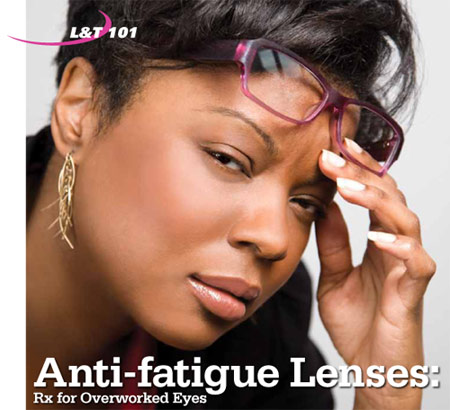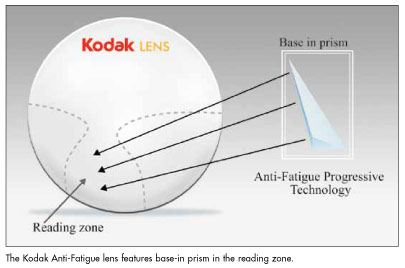
Photograph by Dan Kaiser/Blackbox Studio; FRAME: Jil Sander 2624 from Marchon
By Timothy Coronis, ABOC-NLCE
In today’s multitasking, info-overloaded world, it’s increasingly common for many of us to work online for hours, send text messages to friends and then relax by watching YouTube videos. It’s no surprise then that our eyes are often stressed to the point of exhaustion. Focusing on small digital screens, one to three feet away for an extended period of time can cause blurred vision, headaches and discomfort as the eye’s internal lens accommodates to maintain plus power for focusing at these distances.
Fortunately, several manufacturers—Signet Armorlite, Essilor and Hoya Vision Care—have recently developed specialized lenses to help us perform these types of near and intermediate visual tasks. The new products, known as anti-fatigue or AF lenses, offer patients relief from digitally induced eyestrain and other visual stress.
AF lenses are versatile and can be worn for many near and intermediate visual tasks, not just computer use. Doctors and dispensers may find it helpful to think of them as occupational and recreational lenses that are suitable for any activity that involves accommodating for near. AF lenses are available in several designs including single vision, “office” progressives and full-range progressives, and can be prescribed for presbyopes, pre-presbyopes and children.
When recommending an AF lens, eyecare practitioners need to understand the features and benefits of each lens design as well as how it ought to be used.
A pre-presbyope, for example, would probably require a single vision lens such as Essilor’s anti-fatigue lens. It features a “boost” at the bottom of the lens in the form of a +.60 diopter increase in plus power, which allows the eye muscles to relax. As a result, accommodation is more easily maintained during the course of the day and visual fatigue is reduced.
Another option for pre-presbyopes is Hoya Vision Care’s Nulux Active 8 lens, which is currently available in Canada but not yet offered in the U.S. The lens utilizes a vertical-aspheric lens design with an increase of plus power in the lower portion. Designed for single vision wearers under age 45, Nulux Active 8 corrects vision for a variety of activities and is intended for all day wear. The radial aspheric feature from the center of the lens reduces barrel and pincushion distortion. The vertical aspheric feature of the bottom portion of the lens provides more relaxed binocular vision. The patient’s mono PDs and OC heights must be supplied to the lab, along with their Rx.

Among the progressive lens choices is the Kodak Anti-Fatigue lens from Signet Armorlite, which is available in the company’s Unique, Precise, Precise Short and Concise designs. The lens features base-in prism in the reading area that is calculated digitally, easing eyestrain from accommodating. Corridor lengths are optimized to the presbyope’s particular prescription and frame “B” measurement, delivering good optics to the wearer and making the correction more easily tolerated, more successfully worn.
Essilor also offers a computer lens that features a big, usable intermediate zone, a smaller near zone and a minimized distance zone that is designed to relieve eyestrain in presbyopes working at computer and near distances for a few hours or more. It is designed to work in frames with a “B” measure of 30mm or more.
 Putting Anti-fatigue Lenses to Work
Putting Anti-fatigue Lenses to Work
L&T asked several optometrists who have successfully prescribed anti-fatigue designs to share their insights about the lenses and the types of patients who have benefitted from them.
John Gunning, OD, of Chillicothe, Ohio, who prescribes Essilor Anti-Fatigue lenses, says he has recommended the lenses to first-time moderate hyperopes, pre-presbyopes and frequent computer users. “College students love the lenses,” he notes.
“I have used this design for true, long-term computer operators,” continues Dr. Gunning. “For these patients I prescribe the intermediate prescription, which focuses these eyes at the computer screen. The ‘boost’ allows them to also see their reading materials clearly. This overall design gives the computer operator great vision at the computer screen with a minor near point “range of vision.”
Dr. Gunning believes the Essilor AF lens works well for emerging presbyopes. “This is an ideal lens to address the symptoms of pre-presbyopia for two reasons: it relieves the symptoms and is better accepted by the patient. I explain to the patient this lens can keep them out of the bifocal for a year or two. It is a bridge between single vision lenses and multifocals.”
The Essilor Anti-Fatigue lens can be prescribed as an intermediate lens with a boost for near, notes Larry Wan, OD of Family Eyecare Center in Campbell, Calif.
“You’ll be most successful thinking of it as more than a computer lens,” says Dr. Wan. “In fact, it improves vision for all sorts of activities, from playing cards to more obvious examples such as computer use.”
Dennis Idarola, OD of the Center for Vision Care, Monroe, Conn., recommends AF lenses for children. “Any patient, especially a child, that demonstrates a near exophoria of greater than six prism dipoters is encouraged to get lenses with AF technology,” says Dr. Idarola, who prescribes Kodak anti-fatigue progressives. “As a fan of small amounts of prism—usually ½ BI—for children and computer users, I am not surprised at all by the success my patients are having with AF technology. Children excel in school since using the AF and I have had comments from the doctors doing vision therapy that they, too have noticed children performing better with the addition of the AF technology.
“I had an 11-year-old girl with convergence insufficiency who hated wearing her bifocal glasses,” says Dr. Idarola. “It wasn’t the cosmetics as much as it was that she did not perceive any improvement in her vision. Today, upon follow up after being fitted with AF, she is more than happy to wear her glasses; she is excited. More importantly, in the last month, her mother is thrilled with her improved reading skills and school grades.
Dr. Idarola adds that he also recommends AF lenses to patients who suffer fatigue at the end of the day, as well as avid readers and computer users.
Sheldon Salaba, OD of Advanced Vision in Ontario, Canada prescribes Hoya Nulux Active 8 for the majority of his patients who are under age 43. “They are great for emerging presbyopes, technology users, basic esophoria patients, convergence excess patients, latent hyperopes, college myopes and over-minused patients,” he says.
Dr. Salaba cites the case of a 12-year-old patient who is an accommodative esotrope. “She presented to my office wearing a lined bifocal,” he explains. “I was able to increase her hyperopic prescription in the distance, add prism correction to address the residual esophoria at distance and then use the +1.00 reading power in the anti-fatigue lens to eliminate the need for a lined bifocal to address her accommodative esotropia. She was ecstatic and loves her glasses. Her problems were addressed and we were able to eliminate her need for a lined bifocal in her glasses.”
Dr. Salaba reports that “in the age group between 15 to 30 years, these patients will have very small prescriptions, or even be emmetropic but they will experience accommodative spasms from going back and forth between two viewing distances. Anti-fatigue lenses are fantastic because they break the accommodative spasm and allow the patient to go back and forth between distance and near tasks without having to take the glasses off.”
According to Dr. Salaba, he has prescribed AF lenses to about 400 patients and has only had 10 to 15 patients reject them. “I am now seeing patients who have had these lenses for over a year and they are very satisfied with the results. They love their glasses.”
Timothy Coronis is an optician and writer based in New Hampshire.













